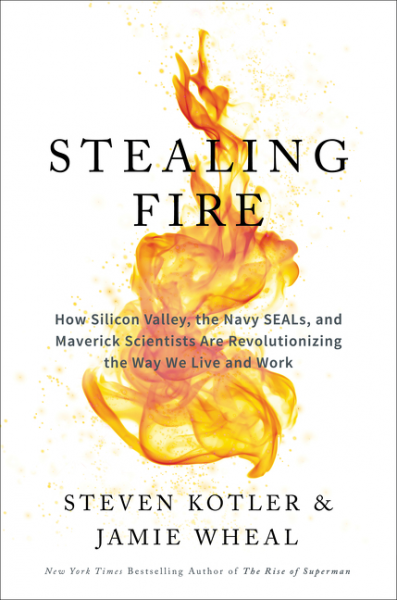I’m a big supporter of the writing of Steven Kotler (Abundance, West of Jesus), who did an incredible talk on flow at The Society Intensive. For the past year, I’ve been watching his latest book, written with Jamie Wheal, take shape: Stealing Fire: How Silicon Valley, The Navy SEALs and Maverick Scientists Are Revolutionizing the Way We Live and Work
One of the many exciting ideas in it is about how to rewire your mind to overcome just about any obstacle. Tactics like these are essential ingredients in the precision of Navy SEAL snipers, the focus of Tibetan monks, and the success of elite athletes.
In a sense, the book is about a new psychedelic revolution that has been increasingly in the zeitgeist over the last few years. If the first psychedelic revolution was about tune in, turn on, and drop out, then this one is about tune in, turn on, and level up. Drugs and micro-dosing are one way to get there, but there are other ways to use altered states to enhance performance.
Steven and Jamie have offered to share this excerpt below. If you want to thank them, pick up a copy of the book here. As of this writing, it is already #40 on Amazon with all five-star reviews.

Stealing Fire: How Silicon Valley, The Navy SEALs and Maverick Scientists Are Revolutionizing the Way We Live and Work
by Steven Kotler & Jamie Wheal
An Excerpt
Operating System to User Interface
Abraham Maslow once famously said, “When all you’ve got is a hammer, every problem looks like a nail.” What he meant was, when it comes to problem-solving, we tend to get locked into using familiar tools in expected ways. The technical term for this is the Law of the Instrument. Give someone a hammer and, indeed, they’ll look for nails to pound. But present them with a problem where they need to repurpose that same hammer as a doorstop, or a pendulum weight, or a tomahawk, and you’ll typically get blank stares.
We may be facing a similar situation when it comes to our minds. At least as far back as the French Enlightenment and Descartes’s cogito ergo sum (I think, therefore, I am), we’ve relied on our rational selves—what psychologists call our “egos”—to run the whole show. It’s a Maslow’s hammer kind of reaction. Every issue we encounter, we try to solve by thinking.
And we know it’s not working. Even a quick glance at today’s dire mental health statistics—the one in four Americans now on psychiatric medicines; the escalating rate of suicide for everyone from ages ten to seventy-eight—shows how critically overtaxed our mental processing is these days. We may have come to the end of our psychological tether. It might be time to rethink all that thinking.
With the recent advancements in neurobiology, we now have options: Embodied cognition teaches us that how we move our bodies affects our brains and minds. AI therapy proves that our subconscious expressions can reflect our inner state more accurately than we do. Precognition demonstrates that we can anticipate how we’re going to feel and think in the future by tracking (and even altering) our biometrics in the present. Neurotheology integrates all of these findings and lets us reverse-engineer a whole host of non-ordinary states, just by working backward from our physiology.
Rather than treating our psychology like the unquestioned operating system (or OS) of our entire lives, we can re-purpose it to function more like a user interface (or UI)—that easy-to-use dashboard that sits atop all the other, more complex programs. By treating the mind like a dashboard, by treating different states of consciousness like apps to be judiciously deployed, we can bypass a lot of psychological storytelling and get results faster and, often, with less frustration.
Take, for example, one of the most common ailments of the modern world—mild to moderate depression. Instead of moping around, hoping for things to get better on their own, we can scan our UI and choose an alternate program to run. We could get on a treadmill (studies show exercise is effective for depression in all but severe cases), or get some natural sunshine (70 percent of Americans are deficient in vitamin D, which has a direct impact on mood), or practice meditation for fifteen minutes (a paper in the Journal of the American Medical Association found it as effective as SSRIs and without the side effects). None of these approaches require thinking about our thinking, but each of them can significantly shift our mood.
Choices like these are available not just in our personal lives, but in our professional lives, too. Instead of nervously waiting for a job interview and obsessing about all the things that could go wrong, we can take a page out of Amy Cuddy’s book and stand up, breathe deeply, and power-pose our way to lower cortisol, higher testosterone, and more confidence. Instead of using trendy leadership books and a new mission statement to fire up employees, we can follow ESADE’s lead and use neurofeedback to heighten group coherence and prompt a more productive strategy session.
But most of us, when challenged, will do none of these things. We’ll think more, talk more, and stress more. We’ll wait until after we feel better to go for that walk in the sun, rather than going for that walk in order to feel better. We’ll wait until after we get that job offer to pump our fists and stand tall, instead of the other way around.
That’s because, at first, reorienting from OS to UI can be downright disorienting. If I can change the “wallpaper of my mind” by deliberately shifting my neurophysiology— my breathing, my posture, my brainwaves, or any number of other interventions—what good are all those stories I’ve been telling myself? If I am not my thoughts, then who am I, really?
This idea, that our ego isn’t the be-all and end-all, flourished in Asia for centuries before landing in California in the 1960s. Thoughts were illusions, the swamis and lamas maintained, and nirvana lay on the other side of ego death. But, for modern Americans, all those earnest (and sometimes addled) attempts to transcend the self didn’t turn out to be that practical. To make sense of today’s fast-paced world, we need our egos to navigate our relationships and responsibilities. We just don’t need to use them like Maslow’s hammer, turning everything around us into a psychological problem to beat on.
Instead, we can stay above our storytelling mind and simply monitor the knobs and levers of our neurobiology. And while this may seem far-fetched, top performers are already there. Tibetan monks can shut off their default mode network (or inner mind chatter) almost at will, SEAL snipers tune their brainwaves to the alpha frequency before locking on to targets, extreme athletes smooth out their heart rhythms right before dropping into a mountain or wave. They’re deliberately doing an end run around their conscious minds. They’re accessing more efficient and effective ways of being, and they’re doing this exactly backward from how most of us have been taught.
Which brings us to ecstasis. When we step beyond our conventional egos and experience the richness of altered states, it’s essential to upgrade our software. Those monkey-suit personas we thought were us (until we suddenly realize they aren’t) don’t need to confine us or define us. “To diagnose . . . yourself while in the midst of action requires the ability to achieve some distance from those on-the-ground events,” Harvard Business School professor Ron Heifetz maintains. “‘Getting on the balcony’ . . . [provides] the distanced perspective you need to see what is really happening.”
And this is what moving from OS to UI delivers: a better view from the balcony.
When we consistently see more of “what is really happening,” we can liberate ourselves from the limitations of our psychology. We can put our egos to better use, using them to modulate our neurobiology and with it, our experience. We can train our brains to find our minds.
Did you enjoy this excerpt? Want more advice and inspiration? Be sure to pick up the complete book today at a local bookstore, or purchase on Amazon here: Stealing Fire: How Silicon Valley, The Navy SEALs and Maverick Scientists Are Revolutionizing the Way We Live and Work.

